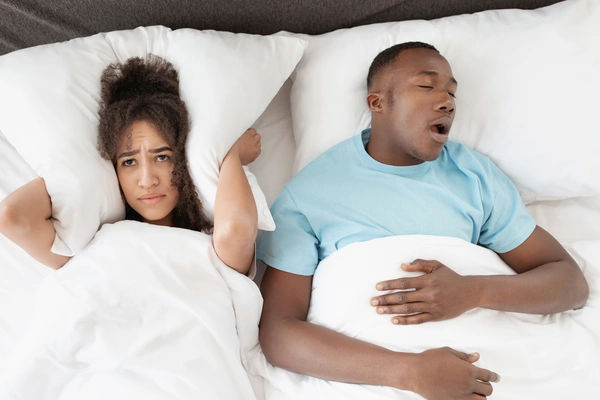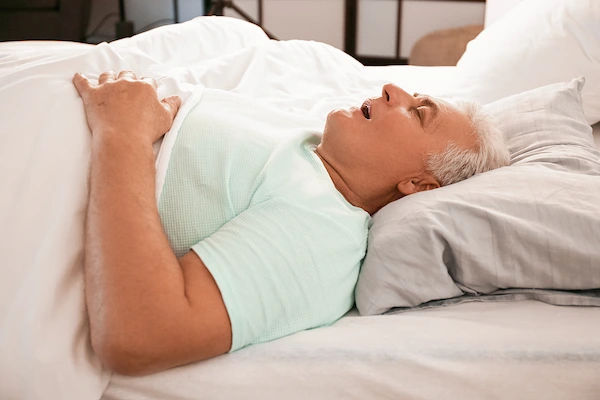Sleep Apnoea: Why Your Breathing Stops for 10-Second Intervals at Night
Learn about sleep apnoea, its causes, signs like 10-second breathing pauses, and effective treatments to reclaim restful sleep.

.webp?tr=q-80,f-webp,w-350,dpr-2,c-at_max 700w)
Introduction
Do you consistently wake up feeling exhausted, despite being in bed for a full eight hours? Does your partner complain about your thunderous snoring, punctuated by alarming gasps or choking sounds? You might be writing it off as a bad night's sleep, but these are classic signs of a common yet serious medical condition: sleep apnoea. This disorder causes your breathing to repeatedly stop and start throughout the night. These pauses, known as apnoeas, can last from 10 seconds to over a minute and can happen hundreds of times a night, severely disrupting your sleep cycle. While you might not remember these micro-awakenings, your body and brain are deprived of the restorative rest they need. This article will serve as your comprehensive guide, helping you understand what sleep apnoea is, how to recognise its often-subtle symptoms, and the crucial steps you can take to diagnose and treat it effectively. Ignoring it isn't an option, as untreated sleep apnoea is linked to a host of long-term health problems.
What is Sleep Apnoea? More Than Just Loud Snoring
Sleep apnoea is a serious sleep disorder characterised by repeated interruptions of breathing during sleep. It's far more than just loud snoring; it's a condition that prevents your body from getting enough oxygen.
The 10-Second Pause: Understanding Apnoeas and Hypopneas
An "apnoea" is clinically defined as a complete cessation of breathing that lasts for at least 10 seconds. A related event, a "hypopnea," is a partial blockage of the airway that leads to a significant reduction in airflow. Each of these events causes a drop in blood oxygen levels. In response, your brain panics and forces a momentary awakening—often so brief you don't remember it—to jerk you awake enough to restart breathing. This cycle can repeat itself all night long, preventing you from reaching the deep, restorative stages of sleep.
The Three Faces of Sleep Apnoea: OSA, CSA, and Mixed
There are three primary types of sleep apnoea:
- Obstructive Sleep Apnoea (OSA): The most common form, affecting approximately 25% of men and nearly 10% of women. It occurs when the muscles in the back of the throat relax too much, causing a physical blockage of the airway.
- Central Sleep Apnoea (CSA): This is less common and involves the central nervous system. The brain fails to send the proper signals to the muscles that control breathing. There is no physical blockage; the body simply makes no effort to breathe for brief periods.
- Complex/Mixed Sleep Apnoea: This is a combination of both obstructive and central sleep apnoeas.
Consult a Somnologist for the best advice
The Silent Nightly Struggle: Recognising the Symptoms
The symptoms of sleep apnoea can be subtle and are often first noticed by a bed partner. They are broadly divided into nighttime and daytime signs.
Nighttime Signs You Might Miss
- Loud, persistent snoring: Not everyone who snores has apnoea, but loud, frequent snoring is a key indicator.
- Witnessed breathing pauses: A partner reporting that you stop breathing for 10 seconds or more is a major red flag.
- Gasping or choking sounds: These often occur at the end of an apnoea as the body struggles to resume breathing.
- Restless sleep and frequent trips to the bathroom.
Daytime Clues Your Body is Sending
- Excessive daytime sleepiness: Feeling overwhelmingly tired during the day, even during activities like driving or working.
- Morning headaches: Caused by the drop in oxygen and rise in carbon dioxide levels overnight.
- Difficulty concentrating ("brain fog") and memory issues.
- Irritability, mood swings, or depression.
- Dry mouth or sore throat upon waking.
Why Does Your Breathing Stop? The Mechanics of an Apnoea
Understanding the "why" behind sleep apnoea is key to addressing it.
Obstructive Sleep Apnoea: A Physical Blockage
During sleep, the muscles in your throat naturally relax. In individuals with OSA, these muscles relax excessively, causing the soft tissue at the back of the throat (the soft palate, uvula, and tongue) to collapse and block the airway. When you try to breathe, the air trying to pass through this obstruction is what causes snoring. When the blockage is complete, breathing stops entirely until the brain's reflex kicks in.
Central Sleep Apnoea: A Communication Breakdown in the Brain
CSA is often associated with underlying medical conditions, such as heart failure or stroke, that affect the brainstem. The brain's respiratory control center becomes unstable, failing to send the "breathe" command to the diaphragm and other breathing muscles. This results in periods of no effort to breathe, unlike OSA where there is effort against a blockage.
The Domino Effect: Health Risks of Untreated Sleep Apnoea
Leaving sleep apnoea untreated is dangerous. The cumulative effect of nightly oxygen drops puts immense strain on the body.
Cardiovascular Strain: Heart Attack, Stroke, and Hypertension
The sudden drops in blood oxygen levels increase blood pressure and strain the cardiovascular system. According to the American Heart Association, sleep apnoea is a leading risk factor for hypertension, heart attack, stroke, and atrial fibrillation. The stress hormones released during each apnoea event can damage blood vessels over time.
Metabolic Mayhem: Link to Type 2 Diabetes
Sleep apnoea is strongly linked to insulin resistance and the development of Type 2 Diabetes. The fragmented sleep and oxygen deprivation can disrupt how your body processes glucose.
The Cognitive and Mental Toll: Brain Fog and Depression
Chronic sleep deprivation directly impacts cognitive function, leading to poor concentration, memory loss, and slow reaction times. It's also a significant contributor to mood disorders like depression and anxiety. If your condition does not improve after trying lifestyle changes, book a physical visit to a doctor with Apollo24|7 for a comprehensive evaluation.
Getting a Diagnosis: From Self-Assessment to Sleep Study
If you suspect you have sleep apnoea, a proper diagnosis is essential.
The Epworth Sleepiness Scale and At-Home Sleep Tests
A good first step is the Epworth sleepiness scale, a simple questionnaire that measures daytime sleepiness. Doctors may also recommend an at-home sleep test. This portable device monitors your breathing, oxygen levels, and breathing effort while you sleep in your own bed.
What to Expect During an In-Lab Polysomnogram
The gold standard for diagnosis is an in-lab sleep study, or polysomnogram. You stay overnight at a sleep center, where sensors monitor your brain waves, eye movements, heart rate, breathing, and blood oxygen levels. This comprehensive data allows a sleep specialist to diagnose the type and severity of your sleep apnoea.
Reclaiming Your Sleep: Effective Treatment Options
The good news is that sleep apnoea is highly treatable. Treatment can dramatically improve your sleep quality, daytime energy, and overall health.
CPAP Therapy: The Gold Standard Explained
For moderate to severe obstructive sleep apnoea, continuous positive airway pressure (CPAP) therapy is the most effective treatment. A CPAP machine delivers a steady stream of pressurised air through a mask, acting as a pneumatic splint to keep your airway open throughout the night. While it takes some getting used to, modern machines are quieter and more comfortable than ever.
Beyond CPAP: Oral Appliances and Positional Therapy
For mild to moderate OSA, a dentist specialising in sleep medicine can fit you with an oral appliance. This device, similar to a mouthguard, repositions the jaw or tongue to keep the airway open. Positional therapy, which involves wearing a device that prevents you from sleeping on your back, can also be effective for some individuals.
Lifestyle Modifications: Weight Loss and Avoiding Alcohol
Lifestyle changes are crucial. Even a 10% reduction in body weight can have a major impact on the severity of OSA. Avoiding alcohol and sedatives before bed is also important, as they relax the throat muscles further. If symptoms persist beyond two weeks of consistent effort, consult a doctor online with Apollo24|7 for further evaluation and personalised advice.
Surgical Interventions: When Other Treatments Fail
Surgery is typically considered only if other treatments have failed. Options include tissue removal, jaw repositioning, or implants that stiffen the soft palate. Surgery aims to enlarge the airway but is not always successful and carries risks.
Conclusion
Sleep apnoea is far more than an inconvenience that leaves you yawning through the day. It is a serious medical condition with profound consequences for your long-term health. Recognising the signs—whether it's your own unrefreshing sleep or a partner's concern about your breathing pauses—is the first and most critical step. The idea that you could stop breathing for 10-second intervals, hundreds of times a night, is frightening, but the path to managing it is clear. With accurate diagnosis and consistent treatment, such as CPAP therapy or lifestyle adjustments, you can reclaim restful sleep, boost your daytime energy, and significantly reduce your risk for associated health complications. Don't dismiss chronic fatigue and snoring as normal. Take action today by speaking with a healthcare professional. Your health, and your sleep, are worth it.
Consult a Somnologist for the best advice
Consult a Somnologist for the best advice

Dr. Shiba Kalyan Biswal
Pulmonology Respiratory Medicine Specialist
18 Years • MBBS,MD,DM(AIIMS Delhi)
Gurugram
APOLLO SUGAR CLINICS GURUGRAM, Gurugram

Dr. Suresh G
General Physician/ Internal Medicine Specialist
25 Years • MBBS, MD
Bangalore
Apollo Clinic Bellandur, Bangalore
(225+ Patients)
Dr. Priya Sharma
Pulmonology/critical Care Specialist
9 Years • DM (PULMONARY MEDICINE), DNB, EDARM, MNAMS
Delhi
Apollo Hospitals Indraprastha, Delhi

Dr. Arjun Ramaswamy
Pulmonology Respiratory Medicine Specialist
9 Years • MD (RESPIRATORY MEDICINE), DM (PULMONARY MEDICINE, CRITICAL CARE AND SLEEP MEDICINE)
Mumbai
Apollo Hospitals CBD Belapur, Mumbai
(75+ Patients)
Dr Srinivas Rajagopala
Pulmonology Respiratory Medicine Specialist
20 Years • MBBS, MD (Int Med), DM (Pul & Crit Care), Fellowship in Lung Transplantation (Toronto)
Chennai
Apollo Cancer Speciality Hospital, Teynampet, Chennai
Consult a Somnologist for the best advice

Dr. Shiba Kalyan Biswal
Pulmonology Respiratory Medicine Specialist
18 Years • MBBS,MD,DM(AIIMS Delhi)
Gurugram
APOLLO SUGAR CLINICS GURUGRAM, Gurugram

Dr. Suresh G
General Physician/ Internal Medicine Specialist
25 Years • MBBS, MD
Bangalore
Apollo Clinic Bellandur, Bangalore
(225+ Patients)
Dr. Priya Sharma
Pulmonology/critical Care Specialist
9 Years • DM (PULMONARY MEDICINE), DNB, EDARM, MNAMS
Delhi
Apollo Hospitals Indraprastha, Delhi

Dr. Arjun Ramaswamy
Pulmonology Respiratory Medicine Specialist
9 Years • MD (RESPIRATORY MEDICINE), DM (PULMONARY MEDICINE, CRITICAL CARE AND SLEEP MEDICINE)
Mumbai
Apollo Hospitals CBD Belapur, Mumbai
(75+ Patients)
Dr Srinivas Rajagopala
Pulmonology Respiratory Medicine Specialist
20 Years • MBBS, MD (Int Med), DM (Pul & Crit Care), Fellowship in Lung Transplantation (Toronto)
Chennai
Apollo Cancer Speciality Hospital, Teynampet, Chennai
More articles from Sleep Apnea
Frequently Asked Questions
Can you have sleep apnoea without snoring?
Yes. While snoring is common, it's not always present, especially in cases of central sleep apnoea. Silent symptoms like daytime fatigue and morning headaches can still indicate a problem.
What is the best position to sleep in if you have sleep apnoea?
Sleeping on your side is generally best for obstructive sleep apnoea, as it helps prevent the tongue and soft tissues from collapsing backward and blocking the throat. Back sleeping (supine) often worsens symptoms.
Can weight loss cure sleep apnoea?
In many cases, significant weight loss can reduce the severity of sleep apnoea or even eliminate it, as it decreases the fatty tissue around the airway. However, it may not be a cure for everyone, especially if anatomical factors are involved.
What are the side effects of using a CPAP machine?
Some users experience initial side effects like nasal congestion, dry mouth, or skin irritation from the mask. These are often manageable by adjusting the machine's humidity settings, trying different mask styles, or using nasal sprays.
Is sleep apnoea a lifelong condition?
For many, it is a chronic condition that requires long-term management. However, with consistent treatment, its symptoms and health risks can be effectively controlled, allowing for a normal, healthy life.


.webp)